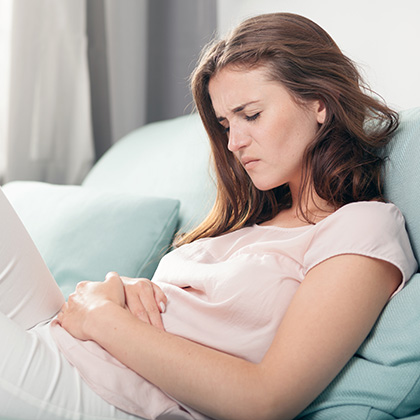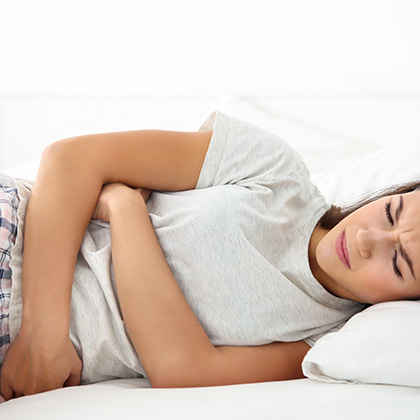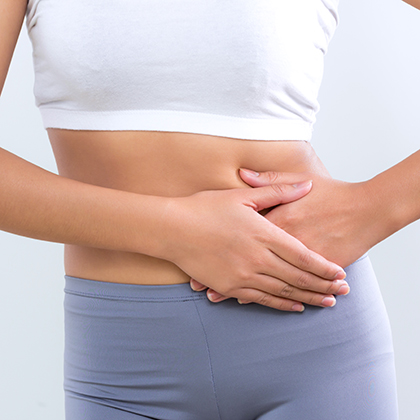The butt of many jokes – no pun intended – haemorrhoids are no laughing matter. Also more commonly known as piles, they’re not something you should be embarrassed about either, as many people in this country develop one or more haemorrhoids at some point. Indeed, up to 36 per cent of us report having haemorrhoids, says the National Institute of Health and Care Excellence (NICE), though this is just an estimate and the real number may be much higher (i). If you’ve been affected by them, you’ll know that haemorrhoids can make your bottom itch, and possibly also a bit sore and swollen. You may have been alarmed to find a bit of bright red blood after going to the toilet too, or after discovering a little swollen lump around your anus.
What are haemorrhoids?
Haemorrhoids develop when veins found in the lining of the lower rectum and the anus become swollen and distended - just like varicose veins in the legs.
There are two types: internal haemorrhoids, which develop in the lower rectum, and external haemorrhoids, which develop under the skin around the anus. Of the two, external haemorrhoids are the most uncomfortable, especially if a blood clot forms inside one (this can be extremely painful). Internal haemorrhoids are usually painless, but problems can arise when an internal haemorrhoid hangs out from the anus (prolapse).
What causes them?
The good news is that many are small and disappear without any treatment. But what causes them exactly? The truth is, experts still don’t know exactly why haemorrhoids form, since some develop for no obvious reason. Many, however, are linked to increased pressure in and around the veins in the anus and anal canal. This pressure can be caused by having constipation, a prolonged episode of diarrhoea, being overweight or obese, having a bad cough, lifting heavy objects on a regular basis or being pregnant. Ageing can be a factor too, as the older you get, the weaker the lining of the anus becomes. A tendency to develop haemorrhoids can also run in families.
Thankfully, however, haemorrhoids are rarely dangerous.
Haemorrhoid treatments
Most haemorrhoids go away by themselves. But some may require treatment to reduce itching and discomfort. Many treatments suitable for mild haemorrhoids are available over the counter in pharmacies, including creams, ointments, suppositories and wipes. Designed to help relieve swelling and irritation, these products should only be used for a maximum of seven days at a time, as using them in the long term can cause further discomfort. There are several types of products available, including those that contain an anaesthetic to help relieve pain.
If you have a lot of inflammation in the area, your GP can also prescribe a steroid cream to help relieve pain and itching though make sure you only use steroid creams for one week or less at a time, as using one for longer can make the irritation worse.
You may also want to try taking over-the-counter painkillers such as paracetamol if your haemorrhoids are painful (do not, however, take painkillers that contain codeine, as codeine can cause constipation). Laxatives also available without prescription can also help if constipation is a problem.
If, however, you have haemorrhoids that have developed past a certain stage and need to be removed, your GP may refer you to a specialist who may recommend one of the following treatments:
Banding
The most common procedure used to treat haemorrhoids, this involves putting a rubber band at the base of the haemorrhoid, which cuts off its blood supply and causes it to drop off a few days later. The procedure is usually performed at a hospital outpatient clinic, and you don’t usually need an anaesthetic. About eight out of 10 cases of haemorrhoids are effectively treated using banding, with haemorrhoids recurring in just two out of 10 cases at some stage.
Sclerotherapy
Sometimes used instead of banding, sclerotherapy involves injecting a solution of phenol in oil into the base of a haemorrhoid. The solution numbs the nerve endings, relieving pain and hardening the tissue of the haemorrhoid. Then after six weeks or less, the haemorrhoid should shrivel up and drop off.
Infrared coagulation
This procedure involves using an infrared device to burn the haemorrhoid and cut off its blood supply, causing it to shrink. Other methods called diathermy and electrotherapy are similar, but instead of using infrared they use heat to destroy haemorrhoids.
Surgery
Some people with haemorrhoids will eventually need surgery to treat their condition if other treatments haven’t been successful. There are a few different types of surgery for haemorrhoids, including a haemorrhoidectomy (where the haemorrhoid is cut away under general anaesthetic), stapled haemorrhoidopexy (or stapling, which is also carried out under general anaesthetic), haemorrhoidal artery ligation (an operation that blocks the blood supply to a haemorrhoid) and less frequently other treatments that include laser removal and freezing.
How to prevent haemorrhoids
There are lots of things you can do to reduce your chances of developing haemorrhoids. See how you get on with the following self-help measures:
Eat more fibre
The straining associated with constipation is one of the most common things that triggers haemorrhoids. However, you can avoid becoming constipated by eating more fibre. Make sure your diet includes plenty of whole grains, fruit, vegetables, beans, legumes, nuts and seeds. If this doesn’t help, consider taking fibre supplements, which are widely available as liquids and in sachets.
Drink plenty of fluids
Constipation can also be caused by not drinking enough fluids, particularly water. Aim to drink at least 1.6 litres of fluid a day if you’re a woman and 2 litres a day if you’re a man (that’s about eight and 10 glasses). All drinks count, including water, lower-fat milk and sugar-free drinks such as tea and coffee, says the NHS (iii). If you don’t like plain water, try sparkling water or add a slice of lemon or lime.
Stay active
Another way to prevent constipation is to exercise regularly. You should be trying to be moderately active for a total of 150 minutes a week (moderately active means you should be warm and slightly out of breath but still capable of carrying on a conversation). If you have a sedentary job or lifestyle, it’s also a good idea to try and sit down less by taking regular breaks to get up and walk around your home or place of work, since sitting for prolonged periods can put pressure on the rectum.
Lose weight
Being overweight or obese can increase your risk of developing haemorrhoids, so losing some of those excess pounds could help to keep you haemorrhoid free.
Keep cool
An ice pack or cold compress applied to the area can help to relieve pain and swelling. Always make sure ice is wrapped in a towel or something similar before applying it to any area of your skin, and only leave an ice pack in place for a few minutes.
Don’t hold it in
If you feel the need to go to the toilet, don’t put it off. Holding it in could make the faeces harder and more difficult to pass if you wait. Also try to avoid straining or spending too long sitting on the toilet.
Go for a soak
This requires time and a little bit of effort, but if you can, try soaking your anal area in warm water for up to 15 minutes, two or three times a day. You can do this in a shallow bath or, if you have one, in a bidet. At the very least, make sure your anal area is always clean ? but don’t use soap or perfumed wipes, as they may aggravate the skin in this area.
Haemorrhoids myths and facts
There are several myths surrounding the subject of haemorrhoids, largely because of the embarrassment factor. Here are the main ones you should be aware of:
MYTH: sitting on a cold floor can cause haemorrhoids
This may be something your mother told you when you were a child, but there’s no truth in it. If anything, the opposite may be true, since sitting on a cold surface could encourage veins in the rectum to move higher into the body. Sitting down on any surface for long periods of time could, however, increase your chances of developing haemorrhoids, thanks to the strain prolonged sitting puts on the rectum.
MYTH: haemorrhoids are caused by eating spicy food
This popular myth may have arisen from the fact that some people tend to develop digestive problems after eating extremely hot and spicy foods. There is no evidence that chemicals found in spicy food affect the veins in the rectal area, but they may irritate the mucous membranes of the rectum and anus if they haven’t been neutralised in the stomach and gut beforehand.
MYTH: Only older people get haemorrhoids
It’s true that older people are more likely to develop haemorrhoids thanks to the fact that the walls of the blood vessels in the rectum and anus become weaker with age. However haemorrhoids can affect anyone, however old they are, even children (though they are much more likely to affect adults). You could also live to 100 without having any haemorrhoids.
MYTH: Haemorrhoids can cause cancer
While more severe cases of haemorrhoids can be painful, there is no link between them and any form of cancer. There again, experts believe that, in some cases, having cancer may make you more likely to develop haemorrhoids, plus haemorrhoids can cause certain symptoms that are similar to those of bowel cancer both of which are good reasons to get yourself checked out by your GP if you suffer from them.
MYTH: Haemorrhoids are caused by a sexually transmitted infection
Haemorrhoids are not a symptom of a sexually transmitted disease, neither can they be passed from one person to another. There’s also no proof that having anal sex can cause haemorrhoids, though it could well make any existing haemorrhoids worse.
Natural remedies for haemorrhoids
In addition to other lifestyle measures, one way to help prevent and relieve haemorrhoids is to use nutritional products in supplement form. These include the following:
Rutin
This is a bioflavonoid found in foods such as buckwheat, apples, elderflowers and asparagus. Many nutritional experts believe rutin can strengthen blood vessels, which is why it is often recommended to people who have haemorrhoids (it’s also a popular natural remedy for varicose veins). There is also evidence that chemicals derived from rutins called oxerutins may also be helpful for haemorrhoids, including those that affect women during pregnancy (iv).
Fish oils
Eicosapentaenoic acid (EPA) and docosahexaenoic acid (DHA) are the omega-3 fatty acids found in oily fish such as salmon, fresh tuna, sardines, herring and mackerel. These fatty acids may be useful for haemorrhoids because they’re widely believed to help reduce inflammation(v).
If you’re a vegetarian or vegan you can still benefit from an omega-3 supplement, thanks to the availability of products that contain the natural triglyceride (TG) form of omega-3, which is sourced from plant organisms called microalgae rather than fish oils.
Anthocyanidins
Plant pigments found in dark and richly coloured fruit such as blueberries, blackberries, raspberries and red grapes, anthocyanidins are powerful antioxidants. Nutritional practitioners recommend anthocyanidins supplements to people with haemorrhoids as they are thought to help seal up leaky blood vesels by repairing collagen in blood vessels walls and capillaries.
Vitamin C
There is some evidence to suggest that people who have haemorrhoids have lower collagen levels than those who don’t (vi). One way to boost your body’s collagen level may be to take a vitamin C supplement, as experts believe vitamin C plays an important role in maintaining the body’s collagen (vii).
Turmeric
If you have painful haemorrhoids, you may want to try taking a turmeric supplement. Widely used in Indian cooking, turmeric is also a popular ingredient in the Indian system of herbal medicine known as Ayurveda. It belongs to a family of plants called Zingiberaceae, which also includes ginger and galangal. One review that has analysed 18 other studies found that Zingiberaceae extracts are clinically effective hypoalgesic agents ? which means they are effective at treating pain ? but have a better safety profile than conventional painkillers such as non-steroidal anti-inflammatory drugs (NSAIDs) (viii).
Haemorrhoids can be an uncomfortable condition to manage, but this guide should help to ease some of the symptoms. For more information on a range of other common health conditions, take a look at some of the articles on our health library.
References:
-
Available online: https://cks.nice.org.uk/haemorrhoids#!backgroundSub:1
-
Available online: https://patient.info/digestive-health/rectal-bleeding-blood-in-faeces/piles-haemorrhoids
-
Available online: https://www.nhs.uk/live-well/eat-well/water-drinks-nutrition/
-
Wijayanegara. H, Mose. JC, Achmad. L, et al. . A clinical trial of hydroxyethylrutosides in the treatment of haemorrhoids of pregnancy. J Int Med Res. 1992;20:54-60. Available online: https://pubmed.ncbi.nlm.nih.gov/1568520-a-clinical-trial-of-hydroxyethylrutosides-in-the-treatment-of-haemorrhoids-of-pregnancy/
Wadworth. AN, Faulds. D, et al. Hydroxyethylrutosides. A review of its pharmacology, and therapeutic efficacy in venous insufficiency and related disorders. Drugs. 1992;44:1013-1032. Available online: https://pubmed.ncbi.nlm.nih.gov/1282862-hydroxyethylrutosides-a-review-of-its-pharmacology-and-therapeutic-efficacy-in-venous-insufficiency-and-related-disorders/ -
Calder PC. Omega-3 Faty Acids and Inflammatory Processes: From Molecules to Man. Biochem Soc Trans.;45(5):1105-1115. Available online: https://pubmed.ncbi.nlm.nih.gov/28900017-omega-3-fatty-acids-and-inflammatory-processes-from-molecules-to-man/?from_term=omega+3+inflammation&from_pos=1
-
Calder PC. Omega-3 Faty Acids and Inflammatory Processes. Nutrients.;2(3):355-74. Available online: https://pubmed.ncbi.nlm.nih.gov/22254027-omega-3-fatty-acids-and-inflammatory-processes/
-
Willis. S, Junge. K, et al. Hemorrhoids - a collagen disease? Colorectal Dis. 2010 Dec;12(12):1249-53. Available online: https://pubmed.ncbi.nlm.nih.gov/19614671-haemorrhoids-a-collagen-disease/?from_term=Hemorrhoids+-+a+collagen+disease%3F+&from_pos=1
-
Boyera. N, Galey. I, Bernard. BA, et al. Effect of vitamin C and its derivatives on collagen synthesis and cross-linking by normal human fibroblasts. In J Cosmet Sci. 1998 Jun;20(3):151-8. Available online: https://pubmed.ncbi.nlm.nih.gov/18505499-effect-of-vitamin-c-and-its-derivatives-on-collagen-synthesis-and-cross-linking-by-normal-human-fibroblasts/
-
Lakhan. SE, Ford. CT, Tepper. D, et al. Zingiberaceae extracts for pain: a systematic review and meta-analysis. Nutr J. 2015 May 14;14:50. Available online: https://pubmed.ncbi.nlm.nih.gov/25972154-zingiberaceae-extracts-for-pain-a-systematic-review-and-meta-analysis/
Related Posts
Disclaimer: The information presented by Nature's Best is for informational purposes only. It is based on scientific studies (human, animal, or in vitro), clinical experience, or traditional usage as cited in each article. The results reported may not necessarily occur in all individuals. Self-treatment is not recommended for life-threatening conditions that require medical treatment under a doctor's care. For many of the conditions discussed, treatment with prescription or over the counter medication is also available. Consult your doctor, practitioner, and/or pharmacist for any health problem and before using any supplements or before making any changes in prescribed medications.

Christine
Christine Morgan has been a freelance health and wellbeing journalist for almost 20 years, having written for numerous publications including the Daily Mirror, S Magazine, Top Sante, Healthy, Woman & Home, Zest, Allergy, Healthy Times and Pregnancy & Birth; she has also edited several titles such as Women’ Health, Shine’s Real Health & Beauty and All About Health.
View More



